- Stat Significant
- Posts
- Which Music Stands the Test of Time, and Which Does Not? A Statistical Analysis
Which Music Stands the Test of Time, and Which Does Not? A Statistical Analysis
Which music acts endure within our culture, and which fade away?

Bohemian Rhapsody (2018). Credit: 20th Century Studios.
Intro: The Death of Disco
Disco met its end on July 12, 1979, at an unlikely venue—a baseball game. Once a prevailing force in popular culture, the genre's decline reached its climax during a chaotic "Disco Demolition Night" at Chicago's Comiskey Park.
Disco Demolition Night was a promotional event orchestrated by the Chicago White Sox and radio DJ Steve Dahl (an avowed anti-disco evangelist). The event invited fans to bring disco records to a doubleheader baseball game, promising to blow them up in the outfield between contests.
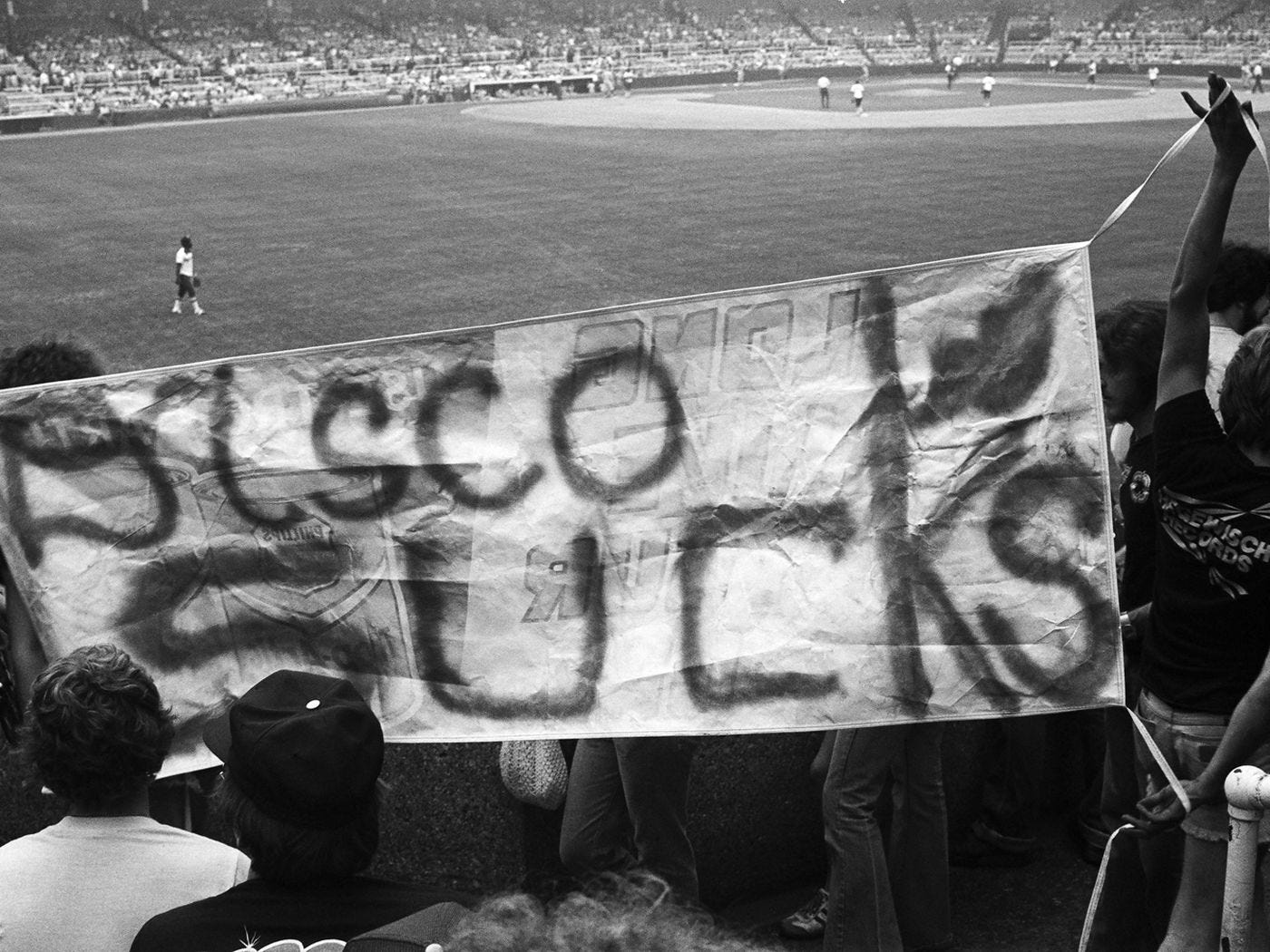
Disco Demolition Night. Source: Wikipedia.
The promotion drew a larger-than-anticipated crowd, with disco haters flocking to Comiskey Park to support Dahl's symbolic (and literal) destruction of the genre. Unfortunately, the disco demolition quickly spun out of control, with explosions damaging the grounds and thousands of fans storming the field, leading to a riot-like situation. The second game of the doubleheader was ultimately canceled, and dozens of Chicago policemen were called to restore order.
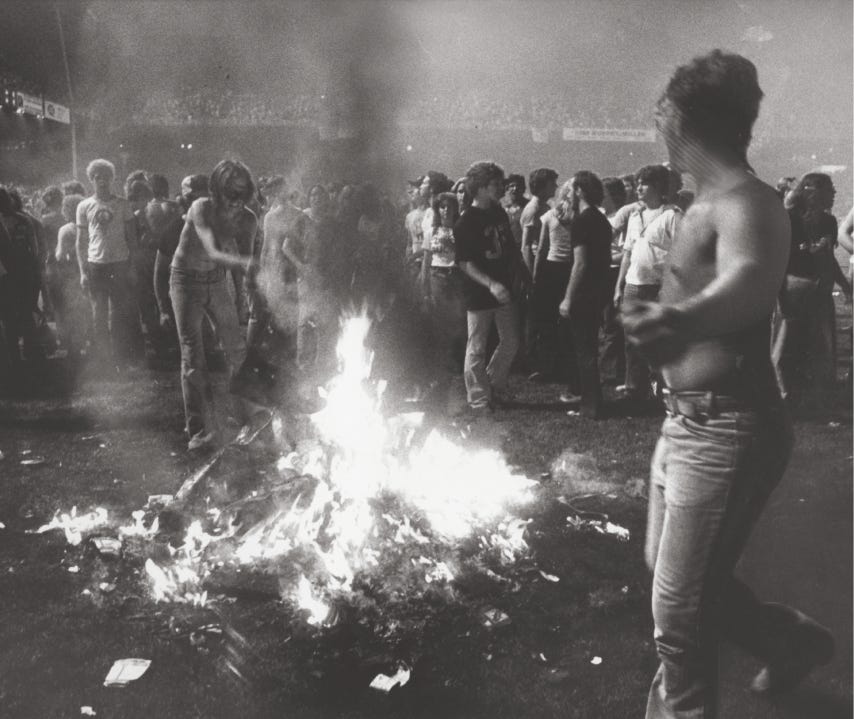
Disco Demolition Night. Source: Wikipedia.
After a decade of cultural oversaturation, anti-disco protests had been proliferating across the US, but none were so visible or of greater consequence. Sure, disco would continue on through the 1980s—it's not like the Bee Gees and Donna Summer simply evaporated—but symbolically the genre was dead, gone less than a decade after its ascension into the mainstream.
Music acts and styles have a decidedly short half-life when it comes to mainstream popularity. Various research and streaming data indicate that music preference is heavily tied to childhood, with popular tastes radically diverging across generations.
Still, not all music is destined for obscurity. A handful of exceptional artists and songs stand the test of time, their works passed down across generations. From Earth, Wind & Fire's "September" to Bruno Mars' "Uptown Funk"—some hits simply defy sonic amnesia.
So today, we'll explore how popular music is forgotten over time, the musicians and genres that maintain unparalleled cultural longevity, and the artists whose once-contemporary success lacks long-term staying power. Most importantly, you'll learn if your favorite works stand the test of time.

News isn’t only violence and crisis. That's why I’m a big fan of Nice News, an email digest that filters through 100+ sources each day to send you the most uplifting news stories. Stay both informed and inspired with their 5-minute daily email digest.
How Quickly Does Popular Music Fade From Collective Memory?
Each year, a song's listenership wanes at a predictable rate, or at least that's the case for 99.99% of popular music. One day, a song like the "Macarena" is inescapable; a year later, significantly fewer people sample this tune; two decades later, this undeniable hit exists as a cultural dinosaur. Personally, I have not heard the "Macarena" played publically in over ten years, but I still remember the dance as a function of Pavlovian brainwashing. Despite my near-perfect recall of the "Macarena," this song, once unavoidable, has faded from collective memory along a near-universal trajectory—like all hit songs before it.
Using a dataset of Spotify streaming stats assembled by our friends at The Pudding (an excellent data culture magazine I highly recommend), we can track listenership for Billboard-charting works as a function of age.
When we graph average Spotify streams by song age, we find an exponential decay function. Pop music quickly exits the mainstream within a decade of its debut; then, this decline stabilizes to a steady, linear rate.
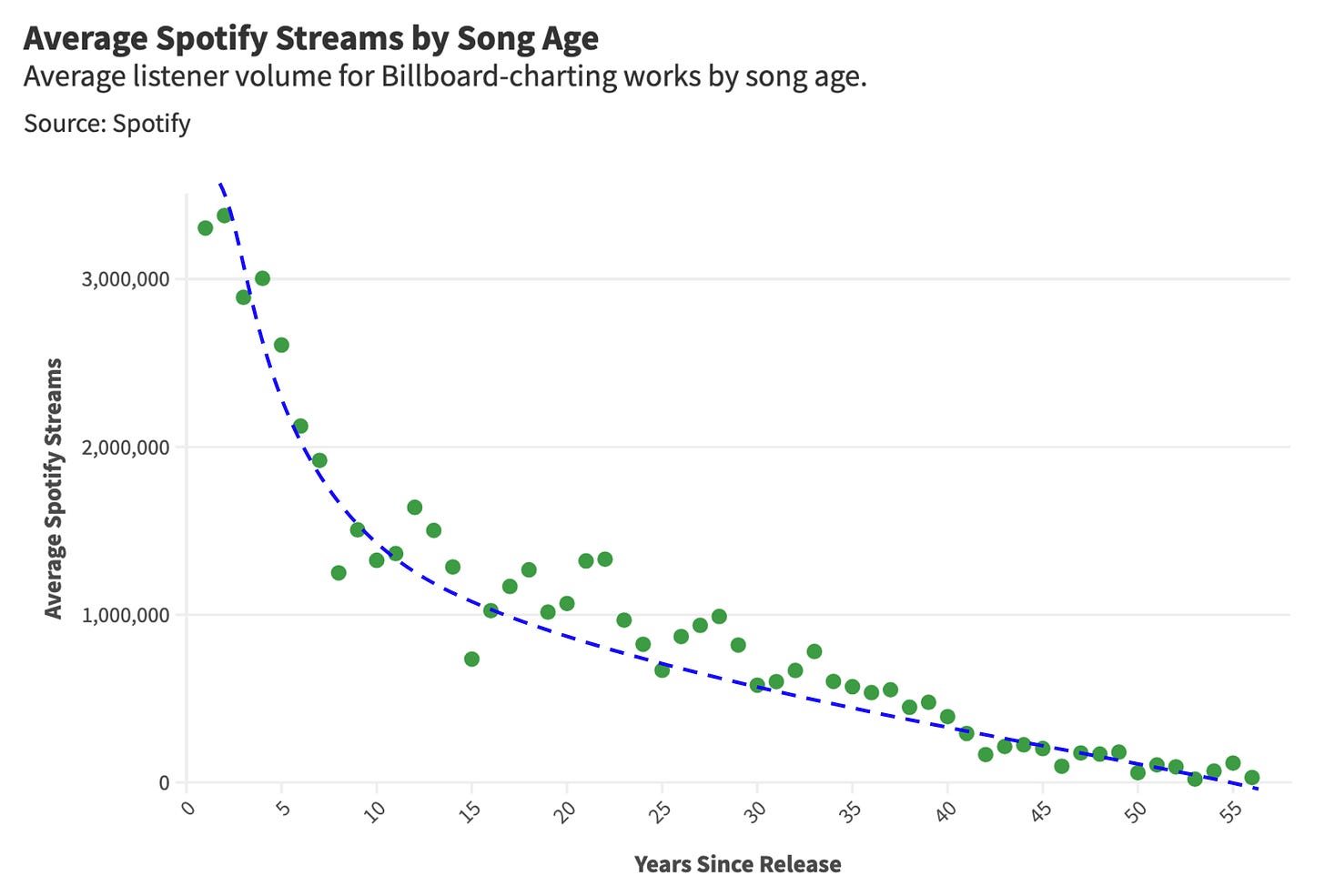
This fast-moving cultural amnesia is highly unique to music. In a previous piece, I analyzed online movie review volume (a proxy for film watching) in the period following a project's debut. Ultimately, we see film consumption fade from collective memory at a linear rate, a significant departure from music's exponential decline.
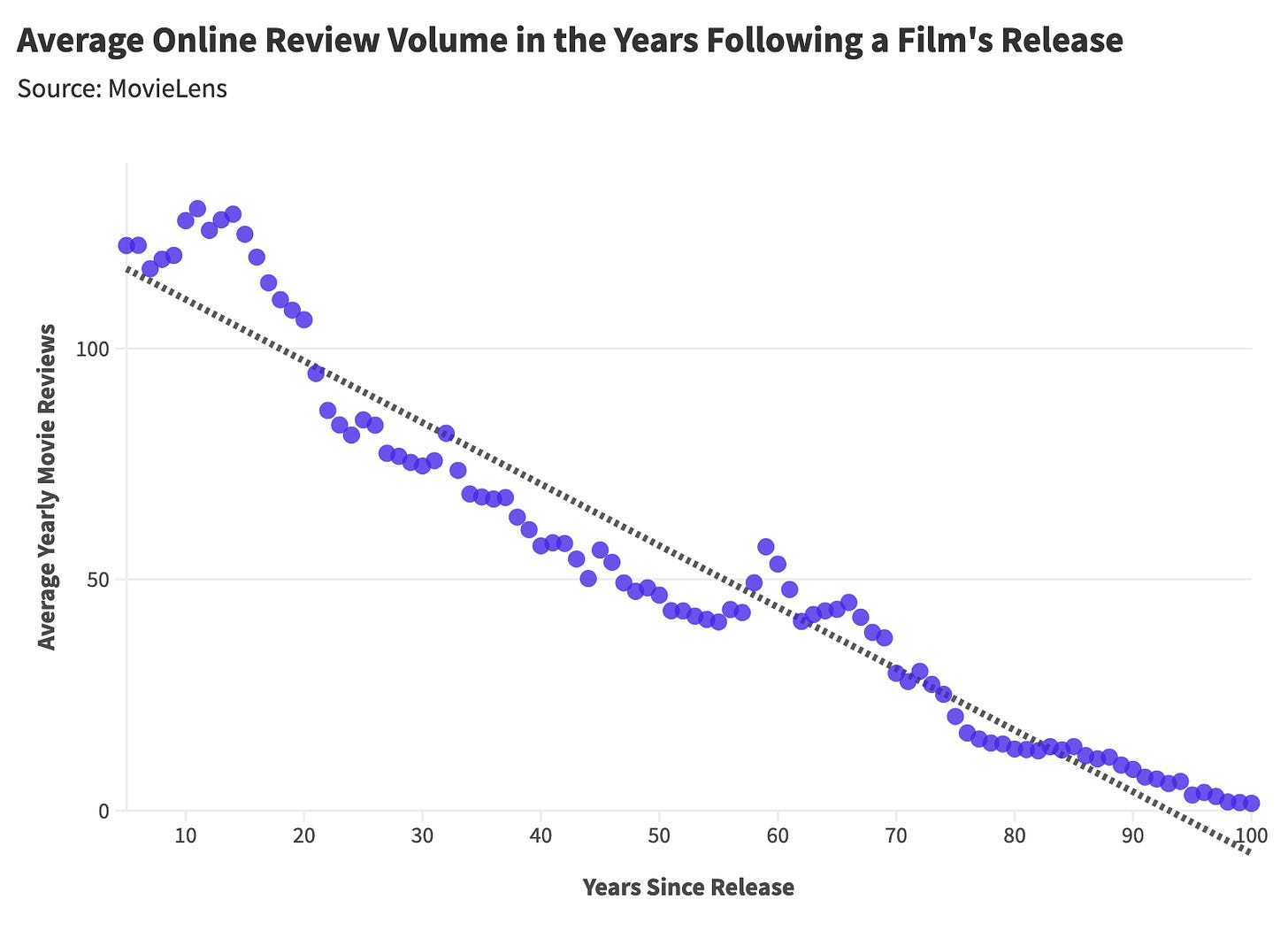
Several factors contribute to the varying cultural longevities of movies and music:
Music Abundance: There is simply more music in the world, providing ample opportunity for stylistic experimentation and evolution. On the other hand, movie production and distribution are heavily resource-constrained, leading to a smaller sampling of films across time.
Breadth and Depth of Consumption: Movies are generally watched once and then set aside, leaving you to search for a new film. Music, on the other hand, can be played ad naseum, sometimes to the point of sonic torture. I listen to The Killers' "Mr. Brightside" nearly every week—two decades after its debut. Most consumers watch a wide range of movies infrequently while playing a smaller selection of songs repeatedly.
Music Preference is Heavily Context Dependent: Music taste is heavily tied to adolescent identity formation and the context during which we hear a song (a high school dance, a wedding, a Bar Mitzvah, etc.). After a certain age, music discovery largely stagnates. In contrast, most movie consumers are in a perpetual state of discovery, seeking new releases and revisiting older works.
Although popular music uniquely fades from the mainstream, its longitudinal consumption patterns are highly predictable. Using this baseline, we can measure a song's streaming activity against the average for its release year.
For example, we project that a 28-year-old song would receive roughly one million streams (in our dataset). Meanwhile, our data indicates that ABBA's "Money Money Money" generated ~2.8 million plays 28 years after its debut and is, therefore, 193% above expected listening volume.
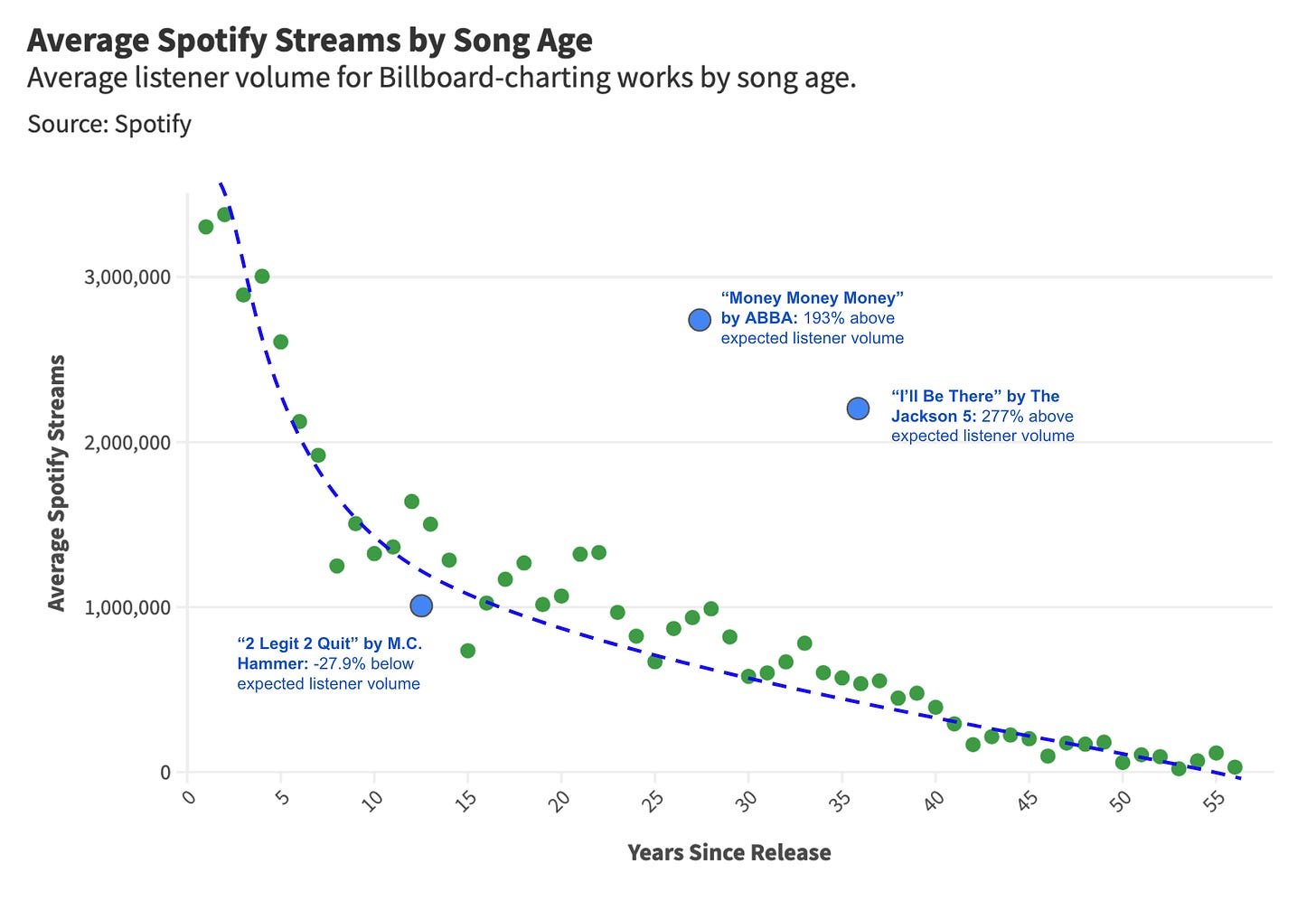
We can perform this comparison for every Billboard-charting hit of the 20th century, analyzing our results by song, artist, genre, and decade. We'll learn which works fade from collective memory and which tunes are evergreen.
Which Songs and Artists Stand the Test of Time?
Our list of the most enduring songs by decade highlights rock and roll's evolution throughout the 20th century, demonstrating the genre's perpetual relevance across varying forms and subgenres. From 1950s pop rock to 1970s soft rock to 1990s grunge rock—our list encapsulates rock and roll's dynamism and persistence.
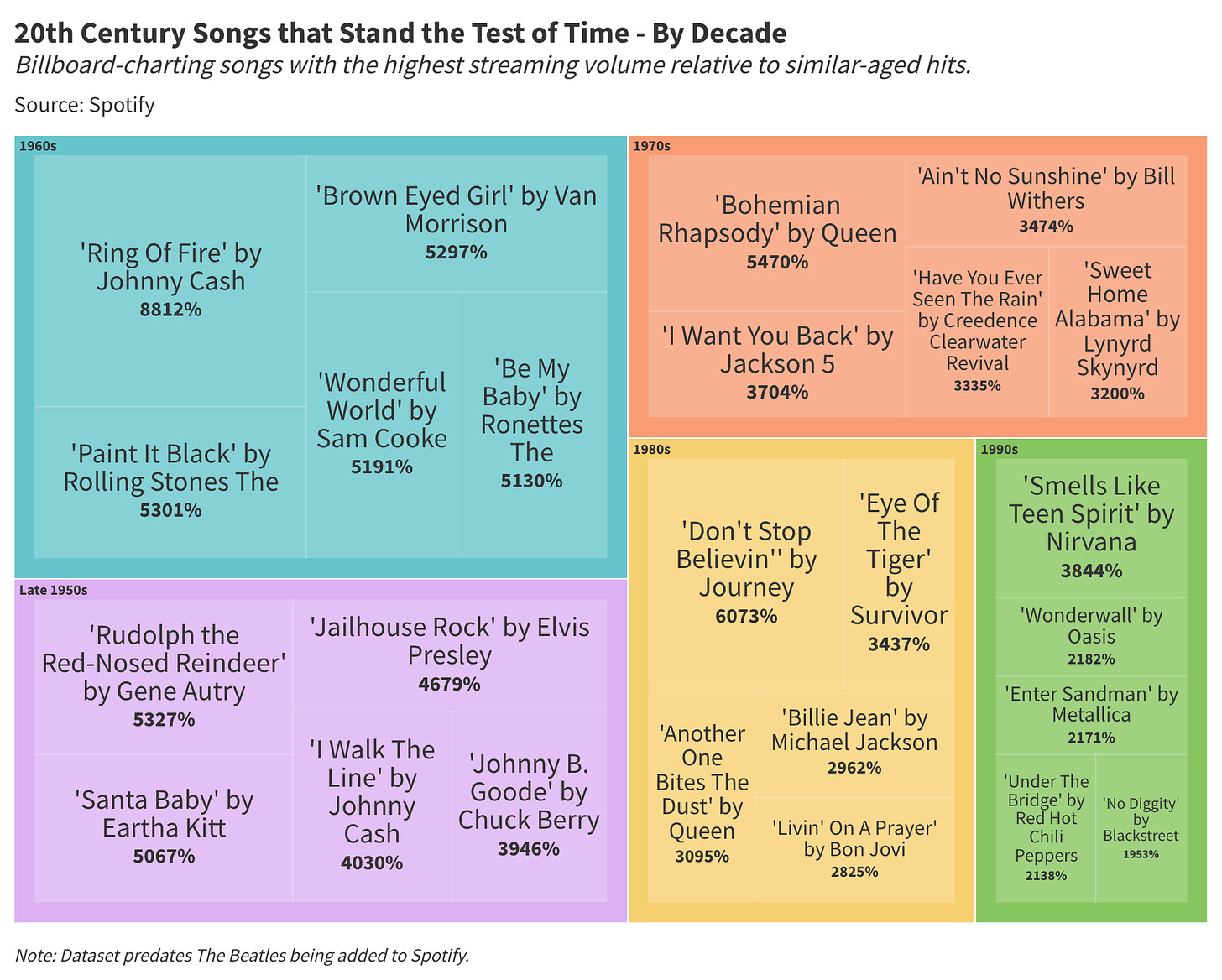
These selections also highlight the cultural staying power of Christmas music, songs whose appeal rests in nostalgia. We listen to "Santa Baby" and "Rudolph the Red-Nosed Reindeer" because these works feel dated, and this anachronistic quality somehow defines the Christmas spirit.
When we examine artists who have stood the test of time, we (once again) observe rock's long-standing cultural dominance. Johnny Cash, Chuck Berry, and Elvis are among the genre's forefathers, and their music is continually revisited more than half a century after its release. The 1960s and 1970s birthed iconic rock groups like The Rolling Stones, Queen, and Fleetwood Mac, as well as global pop stars like Abba (Europe's collective obsession) and Michael Jackson.
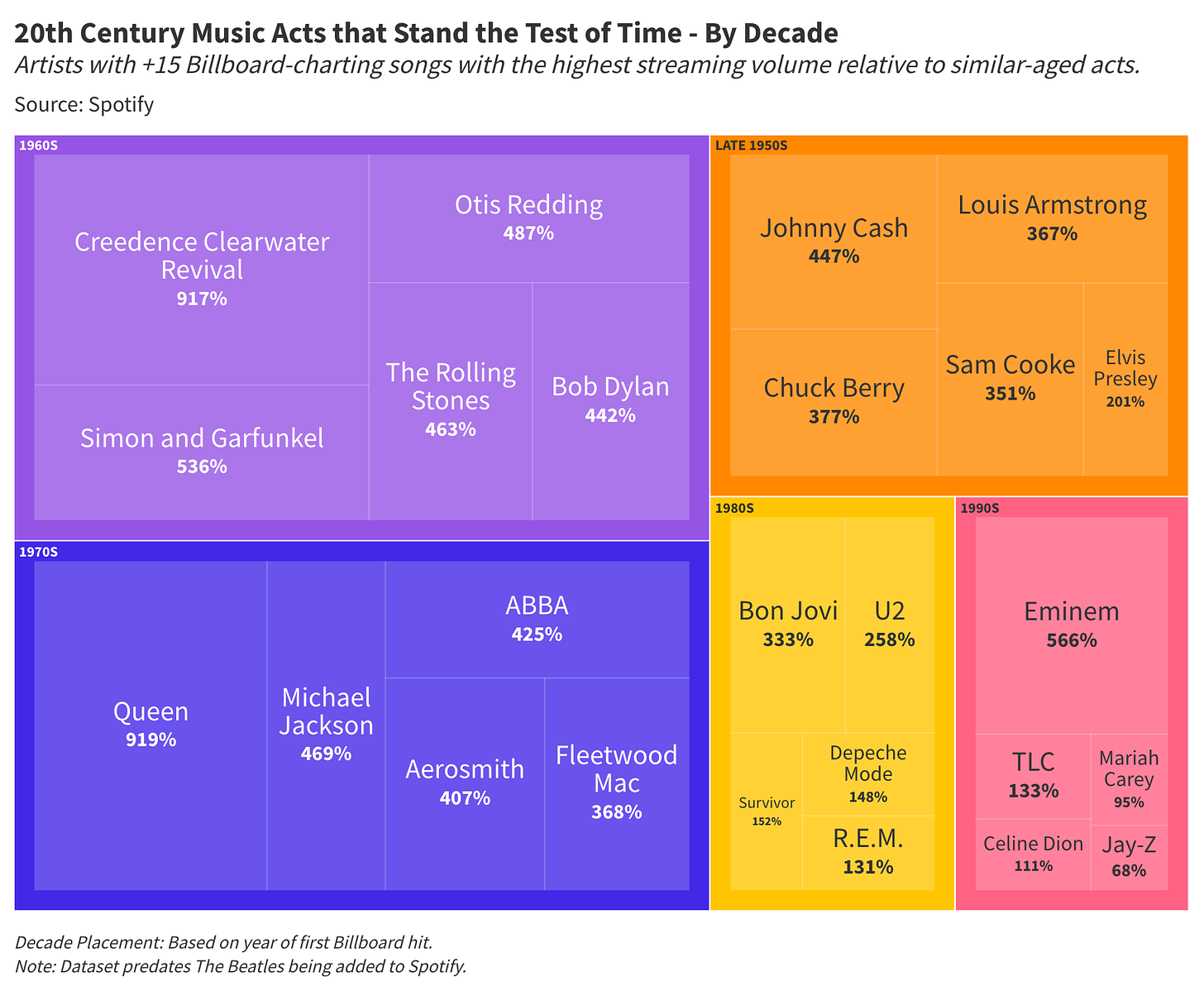
In the 1990s, we see the rise of enduring hip-hop, R&B, and rap acts like Eminem, Jay-Z, TLC, and (somehow) Celine Dion. If we were to analyze releases from the 21st century, we'd likely observe a continuation of rock's decline and rap's ascension. As an aside, it's amazing how one inescapable song ("My Heart Will Go One") from a single mega-blockbuster movie (Titanic) can single-handedly propel Celion Dion to eternal relevance. I do not know any other Celine Dion songs, though evidently, I'm in the minority.
With the exception of a few outliers, 20th century music is dominated by rock and, later, rap. These works have stayed alive within our collective memory, a fixture in radio rotations and Spotify playlists, passed down from generation to generation.
My parents always played Creedence Clearwater Revival, Queen, Abba, and Michael Jackson, and my dad has (with great pride) taken me to Bruce Springsteen and U2 concerts. And yet, as I quantified the indelibility of these musical icons—the artistic high points of my parents' generation—I couldn’t help but wonder what musicians evaded my cultural lineage. What pop acts were deemed unworthy of my time, or more likely, were simply forgotten?
There lies an inherent difficulty in crafting a story around empirically forgettable media. Even when we limit this list to artists with +15 Billboard hits, I greatly struggle with name recognition. Millions of people likely memorized these song lyrics and consider these works crucial to their adolescence, yet according to this data, these artists are now relics.
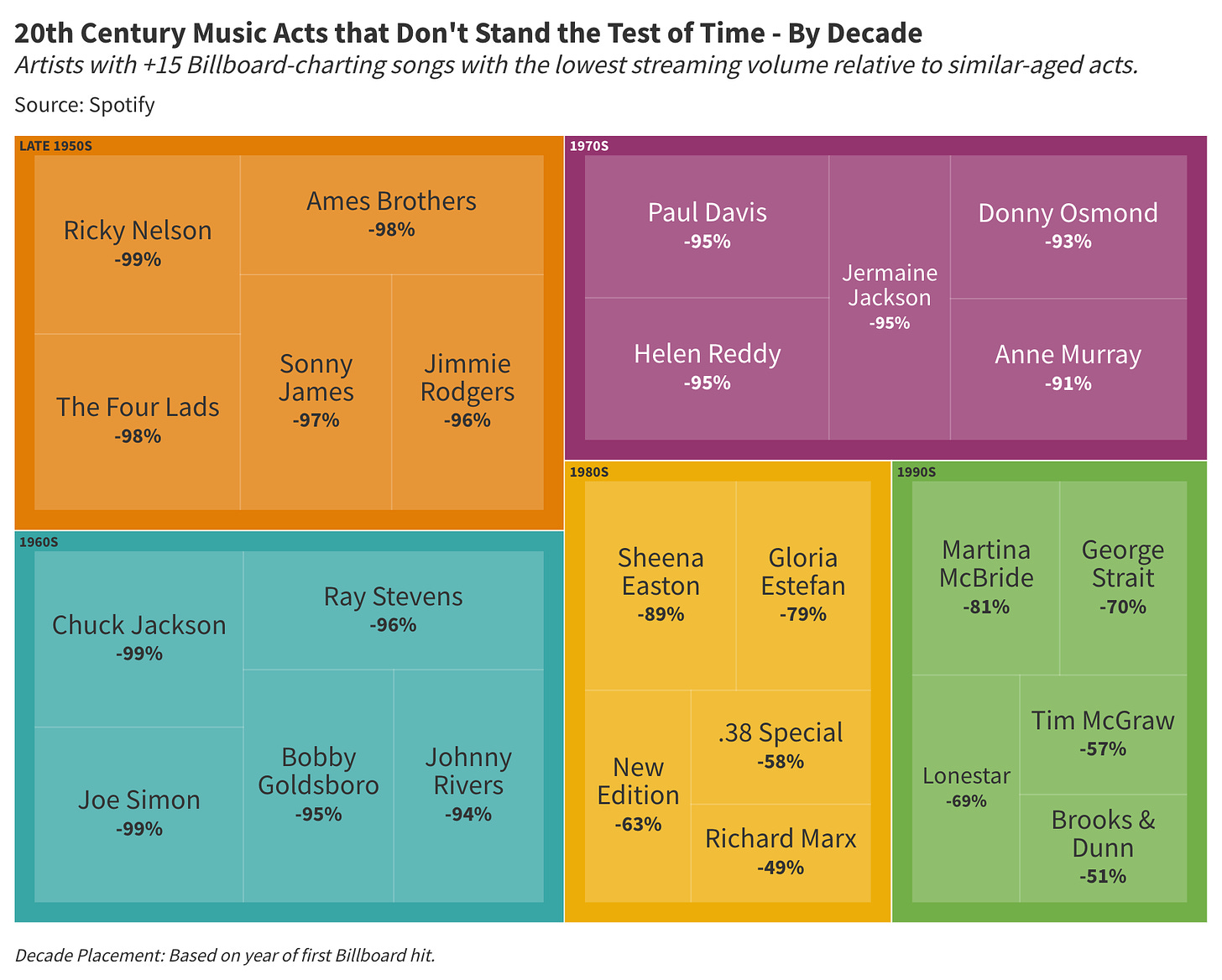
If your favorite music act made this list, consider yourself unique—you cherish a relatively unpopular popular artist.
These acts fall into three broad categories: pop, dance music, and country. I enjoy country music and, therefore, have no intention of using this data (and subsequent insights) to bash the genre. That said, when we average our data by genre, we find country music at the bottom of this list.
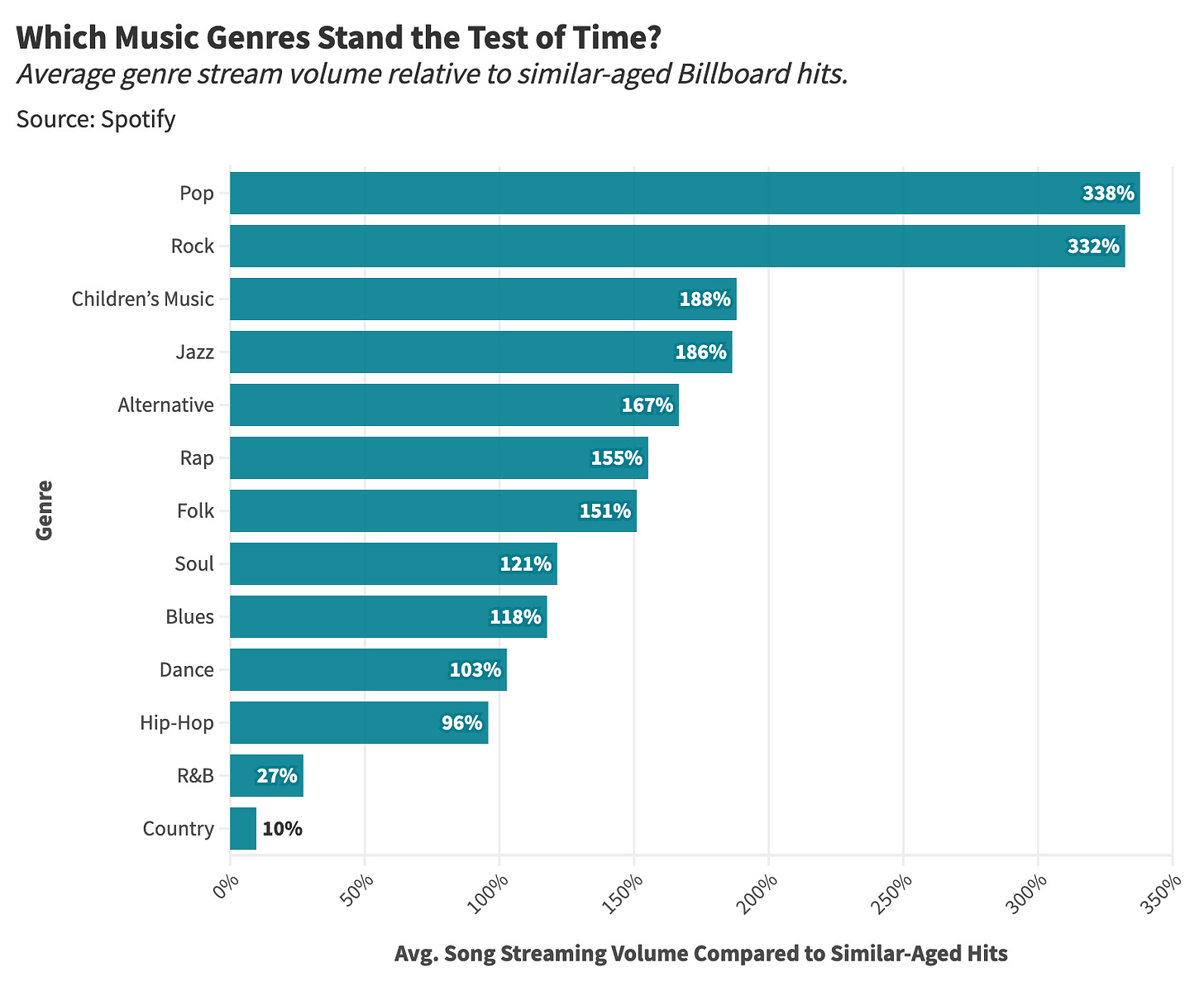
The best explanation I found for this phenomenon cites country's stylistic convergence with pop music in the 1980s, 1990s, and 2000s. Many of the 21st century's biggest country acts, like (early) Taylor Swift, Kacey Musgraves, Keith Urban, and Carrie Underwood, are often considered pop-country crossovers. Perhaps older country music feels dated to modern fans who expect something pop-ier.
Meanwhile, pop, rock, and children's music top our list of enduring genres. Some of this perceived longevity can be attributed to the loose parameters that define these genres. Rock has taken many forms (yacht rock, psychedelic rock, soft rock, etc.), and pop is a decidedly amorphous term. Meanwhile, genres like dance, R&B, and blues are narrowly defined and often tied to distinct eras as a product of this specificity.
Consider "dance," a genre that encapsulates disco (the BeeGees, Donna Summer, etc.) and 1980s dance pop (Paula Abdul, Gloria Estefan, etc.). These works are anachronisms from a time when people, well, danced differently (a time before the beeps and boops of EDM). Meanwhile, rock encapsulates everything from Elvis to Nirvana—quite a broad spectrum.
Even if 21st century rock holds significantly less influence, its historical forebears remain evergreen in our cultural history. Indeed, when we aggregate our data by decade, we find outsized longevity for works from the 1970s (with the aforementioned icons of this era being rock groups). These findings are driven by a high concentration of outliers, with a sizable cohort of mega-hits from the 1970s boosting the decade’s average, such as Queen’s “Bohemian Rhapsody,” The Jackson 5’s “I Want You Back,” and Bill Withers’ “Ain’t No Sunshine.”
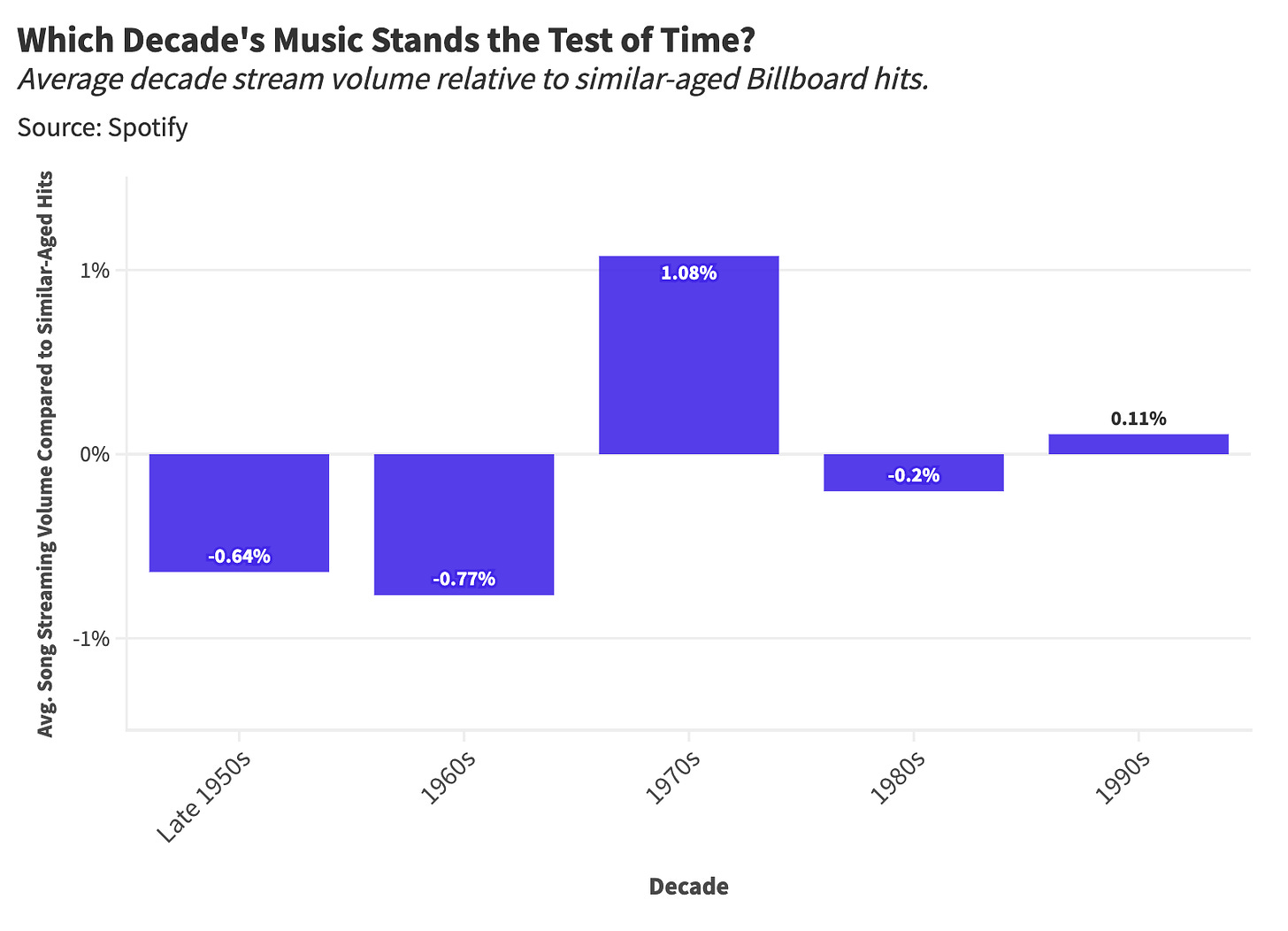
The memorability of a given period rests in its technical and artistic innovations, with hit songs often bearing the stylistic hallmarks of their era. In analyzing Billboard-charting works released between 1957 and 2010, researchers found three major shifts in song composition (denoted in red, orange, and yellow in the graph below):
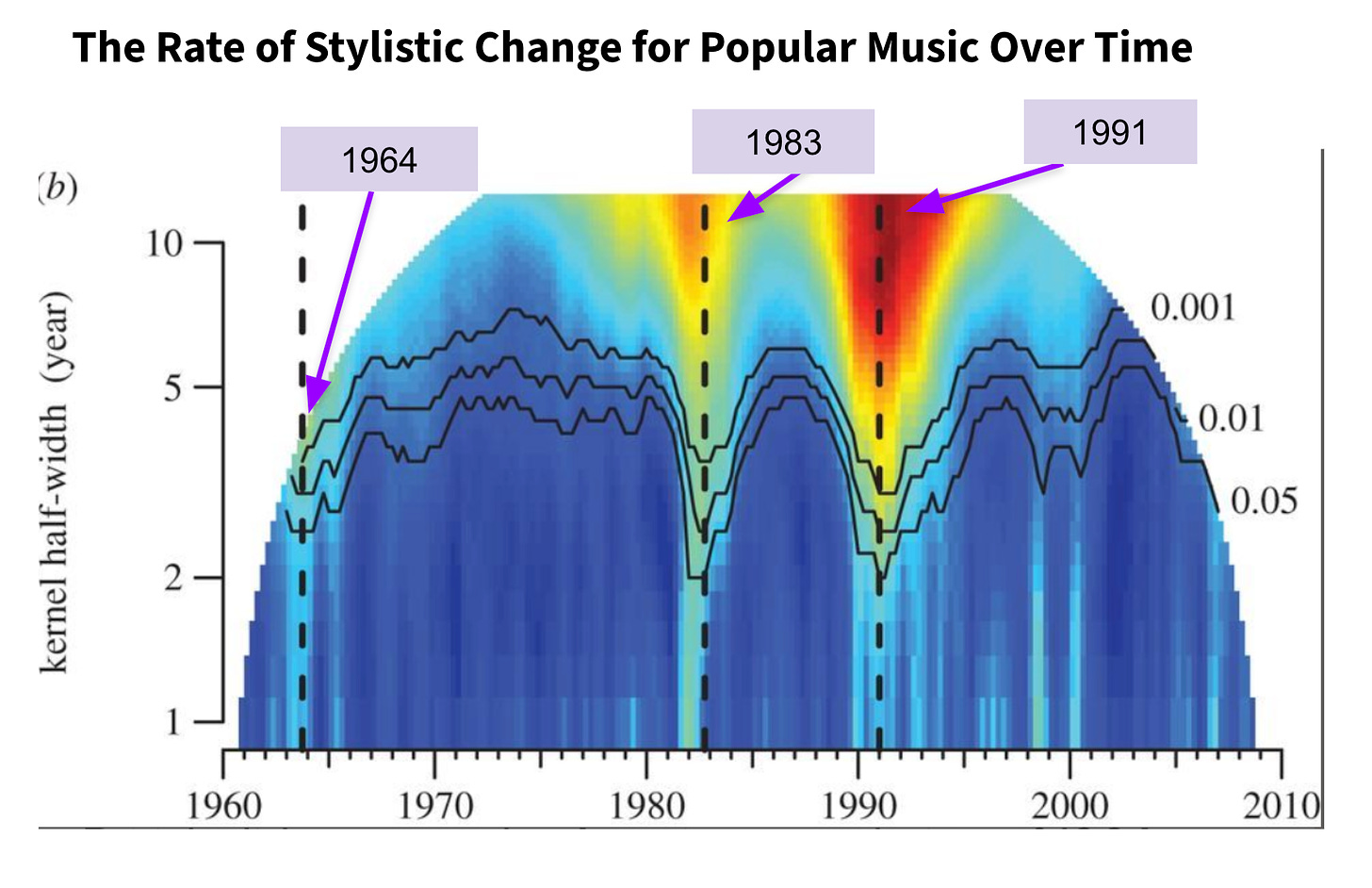
Source: Royal Society Open Science.
1964 - Rock and the British Invasion: The 1964 musical revolution, highlighted by the British Invasion and The Beatles, introduced fresh songwriting styles and innovative recording techniques, including the adoption of multitrack recording. Musically, the mid- to late-1960s catalyzed the diversification of rock into sub-genres and elevated the prominence of folk and soul music, influencing broader cultural movements.
1983 - The Synth Generation: The evolution of music technology, particularly the introduction of synthesizers and drum machines, brought about this revolution. This era was characterized by a shift toward electronic music, influencing genres like new wave, synth-pop, and the early stages of hip-hop.
1991 - Rap and Hip-Hop's Rise: This year marked the mainstream breakthrough of hip-hop and rap, genres that had been growing in influence throughout the 1980s. By 1991, these styles dominated the charts, headlined by rhythmically focused and lyrically complex music.
Every decade or so, we enter a new paradigm with a new-fangled formula for mainstream success. And yet, rock and rap endure, their genre icons remembered despite stylistic obsolescence. So, if you love the music of the late 1960s, the 1970s, or the 1990s, congratulations—you can send these graphics to your friends and family as proof of your superior cultural taste. If you like another music era, consider yourself special—a true iconoclast who contains multitudes. And if you don't like music at all, well, I'm surprised you're still reading this (kudos to you).
Final Thoughts: Where Are Youuuuu?
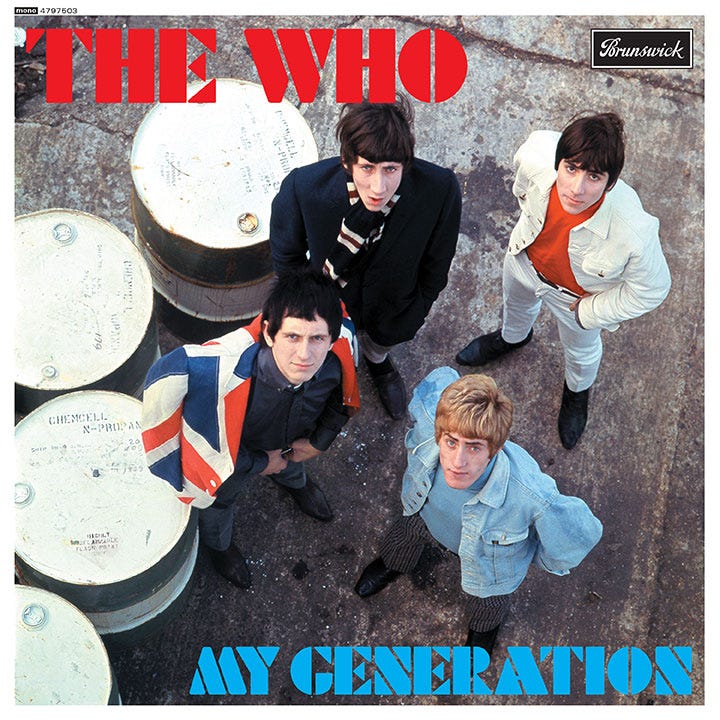
The Who’s “My Generation.” Credit: Brunswick Records.
My initial reading of this analysis was rather cynical: What's the point of loving art that so quickly fades into obscurity? But then I envisioned the counterfactual: What would happen if music tastes never changed? What would the world be like if we lived in a bland, inescapable monoculture? Perhaps music's fleeting significance is somehow beneficial.
Consider Blink-182's "I Miss You"—one of my all-time favorite songs and a generational classic for elder Gen X-ers and Millenials. Blink-182 belongs to a subgenre known as pop punk, which packages the sonic anarchy of 1970s and 1980s punk acts like The Sex Pistols and The Dead Kennedys into a more commercial (heavily sanitized) format. The 1990s saw an explosion of pop-ier punk music defined by catchy melodies, upbeat tempos, and defiant lyrics that resonated with teenage angst. For the low price of $12.99, pre-teens could listen to Blink-182, Green Day, My Chemical Romance, and Fall Out Boy, marveling in a sense of rebellion—but not too much rebellion.

My Chemical Romance’s “Welcome to the Black Parade.” Credit: Reprise Records.
By the 2010s, virtually none of these bands would retain mainstream popularity—becoming vestiges of a particular music style that happened to coincide with my adolescence. Cultural Darwinism had weeded this subgenre out of the zeitgeist.
This leads me to Blink-182's "I Miss You," a song that peaked at number 42 on the Billboard charts nearly twenty years ago. About a minute into this song, after an extended instrumental section, Blink-182's lead singer exclaims, "Where are youuuuu!" in a distinctly shrill and overly melodramatic tone—a moment equal parts shocking and silly. This moment has become iconic (for people of a certain age), a one-line encapsulation of the pop-punk subgenre's angst and absurdity, inspiring memes and clothing alike.

Credit: imgflip.

Credit: Merchill.
Whenever I listen to this song with other millennials, the group waits for this moment with bated breath, collectively whining, "WHERE ARE YOUUUU!" in tandem with Blink-182's Tom DeLonge. There's no better feeling than joyfully shouting these lyrics with good friends.
These three words, and the distinct shrillness of their delivery, may not resonate with Baby Boomers and Zoomers, but they're essential to music consumers of a certain age. I love knowing that two decades ago, teens and tweens across the globe were listening to "I Miss You," noting its peculiarities and unironically embracing its absurd angst. Years later, this song is a way to connect with others—to rejoice in the shared (and highly specific) experience of early 21st century pop-punk fandom. Blink-182's growing obsolescence only deepens this bond, fostering a subcultural connection (amongst formerly angsty millennials).
Seeing your favorite art become a relic can be painful. At the same time, pop culture's transient nature can unite people through shared interest, regardless of mainstream acceptance. If you love the "Macarena," then its present-day obscurity could signify your aging or cultural irrelevance. That said, it's still highly satisfying to do the "Macarena" amidst a crowded dance floor—your moves in perfect synchrony with those around you—even as that crowd shrinks year after year.
Thanks for reading Stat Significant! Subscribe for free to receive new posts and support my work.
Want to chat about data and statistics? Have an interesting data project? Just want to say hi? Email [email protected]
Author’s Note: The dataset used in this analysis predates The Beatles being added to Spotify.